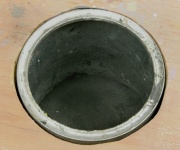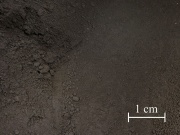Difference between revisions of "Animal black"
(username removed) |
|||
| Line 2: | Line 2: | ||
== Description == | == Description == | ||
| − | An impure black carbon pigment prepared from burnt animal bones. Animal black, or [ | + | An impure black carbon pigment prepared from burnt animal bones. Animal black, or [[bone%20black|bone black]], contains about 10% carbon along with 84% [[calcium%20phosphate|calcium phosphate]] with smaller amounts of [[magnesium%20phosphate|magnesium phosphate]] and [[calcium%20carbonate|calcium carbonate]]. The blue-black pigment is denser than [[carbon%20black|carbon black]] and has a good working quality for oil paints and watercolors. It is also used in engraving inks and as a decolorizing agent for refining sugars and syrups. A fine particle grade of bone black is now sold as ivory black and an inferior grade has been sold under the name of Paris black. Drop black is dried lumps formed after bone black is mixed with water and glue. Drop black was commonly used in the 19th century for house paints. |
[[File:Bone.black_det.jpg|thumb|Bone black]] | [[File:Bone.black_det.jpg|thumb|Bone black]] | ||
| + | |||
== Synonyms and Related Terms == | == Synonyms and Related Terms == | ||
Revision as of 13:55, 7 January 2014
Description
An impure black carbon pigment prepared from burnt animal bones. Animal black, or Bone black, contains about 10% carbon along with 84% Calcium phosphate with smaller amounts of Magnesium phosphate and Calcium carbonate. The blue-black pigment is denser than Carbon black and has a good working quality for oil paints and watercolors. It is also used in engraving inks and as a decolorizing agent for refining sugars and syrups. A fine particle grade of bone black is now sold as ivory black and an inferior grade has been sold under the name of Paris black. Drop black is dried lumps formed after bone black is mixed with water and glue. Drop black was commonly used in the 19th century for house paints.
Synonyms and Related Terms
Pigment Black 9; CI 77267; norsunluumusta (Fin.); noir d'os (Fr.); noir d'ivoire (Fr.); noir animal (Fr.); negro de huesos (Esp.); negro marfil (Esp.); nero d'avorio (It.); nero animale (It.) nero d'ossa (It.) carbone animale (It.); Beinschwarz (Deut.); Elfenbeinschwarz (Deut.); Knochenschwarz (Deut.); ivoorzwart (Ned.); elfenbensort (Nor.); negro animal (Port.); animal charcoal; abaiser; bone black; ivory black; drop black; Frankfort black; German black; Paris black
Other Properties
Particles irregularly shaped.
| Refractive Index | 1.65-1.70 |
|---|
Hazards and Safety
No significant hazards.
Authority
- R. J. Gettens, G.L. Stout, Painting Materials, A Short Encyclopaedia, Dover Publications, New York, 1966
- Ralph Mayer, A Dictionary of Art Terms and Techniques, Harper and Row Publishers, New York, 1969 (also 1945 printing)
- Michael McCann, Artist Beware, Watson-Guptill Publications, New York City, 1979
- Dictionary of Building Preservation, Ward Bucher, ed., John Wiley & Sons, Inc., New York City, 1996
- Monona Rossol, The Artist's Complete Health and Safety Guide, Allworth Press, New York, 1994
- Website address 1 Comment: http://www.coloria.net/varita.htm - foreign language equivalent terms
- G.S.Brady, Materials Handbook, McGraw-Hill Book Co., New York, 1971 Comment: p. 108
- Art and Architecture Thesaurus Online, http://www.getty.edu/research/tools/vocabulary/aat/, J. Paul Getty Trust, Los Angeles, 2000
- Thomas Gregory, The Condensed Chemical Dictionary, Reinhold Publishing, New York, 3rd ed., 1942
- Richard S. Lewis, Hawley's Condensed Chemical Dictionary, Van Nostrand Reinhold, New York, 10th ed., 1993
- The American Heritage Dictionary or Encarta, via Microsoft Bookshelf 98, Microsoft Corp., 1998

